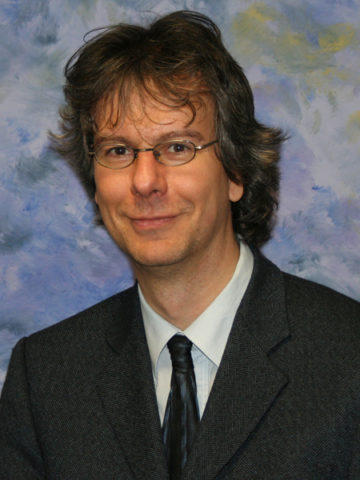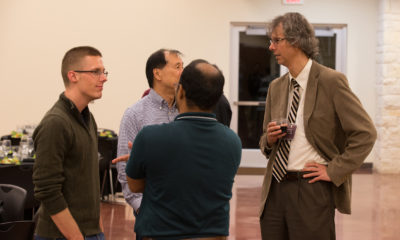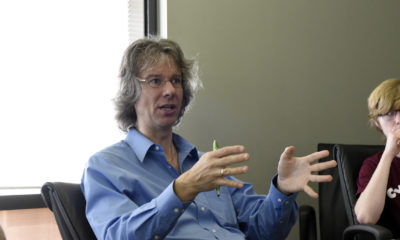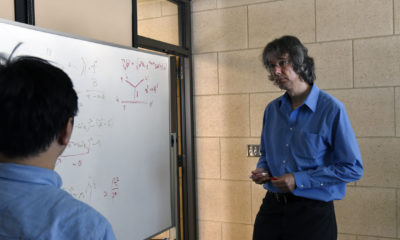 Dr. Ralf Rapp
Dr. Ralf Rapp
Dr. Ralf Rapp
Dr. Ralf Rapp, professor of physics and astronomy and a member of the
Cyclotron Institute at Texas A&M University, is one of four campus faculty named to the 2020 class of University Professorship holders
announced Wednesday (June 10) by Texas A&M Provost and Executive Vice President Dr. Carol A. Fierke.
Established in 2019, the designation recognizes faculty who have demonstrated significant and sustained accomplishments in their discipline, earning them national and international recognition. The award also highlights the recipients’ commitment to inclusivity, accountability, climate and equity in their department, college and throughout their service at Texas A&M.
Rapp, an internationally recognized leader in high energy nuclear physics who joined the
Texas A&M Department of Physics and Astronomy in 2003, earns recognition along with Dr. Susan Saab Fortney, professor in the School of Law; Dr. William Murphy, professor in the Department of Veterinary Integrative Biosciences within the College of Veterinary Medicine and Biomedical Sciences; and Dr. Lin Shao, professor in the Department of Nuclear Engineering within the College of Engineering. He is the second College of Science faculty member to earn the distinction, joining Texas A&M biologist Dr. Deborah Bell-Pederson, who was named to the inaugural class of University Professors in 2019.
Recipients will receive an annual stipend for three years and retain the title throughout their careers at the university as faculty members in good standing. Nominations for the distinction were submitted by department heads or deans, and the finalists were selected by a university committee and approved by the Provost. The professorships are funded centrally from research indirect cost return and philanthropic support.
In this 2017 episode of I Am Texas A&M Science
, Rapp discusses the professional and personal fulfillment he finds in creating new knowledge at the most fundamental levels:
Fierke noted that these awards, in combination with endeavors such as the
President’s Excellence Fund and similar faculty reinvestment programs, serve to empower and advance the careers of faculty at every level.
 Rapp (right) visits with fellow Cyclotron Institute members at a November 16, 2017, banquet celebrating the institute’s 50th anniversary. (Credit: Michael Kellett.)
Rapp (right) visits with fellow Cyclotron Institute members at a November 16, 2017, banquet celebrating the institute’s 50th anniversary. (Credit: Michael Kellett.)“The professorship is intended to help each honoree elevate their impact, which we believe to be imperative to the mission of Texas A&M University,” Fierke said. “These four faculty members are outstanding and clearly serve as role models for both our faculty and our students. It is an honor to recognize them, as I’m deeply grateful for all they do for our university.”
The perpetual title also comes with an unprecedented feature: the option for the holder to personally name the professorship for a significant emeritus or deceased Texas A&M faculty member who has served as an inspiration or motivating factor in the recipient’s career and scholarship.
“I feel extremely honored being awarded a University Professorship,” Rapp said. “I much appreciate the opportunities that have been afforded to me at Texas A&M to build my research program. Over the years, my students and postdocs have worked hard and made some good progress, using electromagnetic radiation and heavy-quark transport to understand the properties of the quark-gluon plasma and its transition back into hadrons. But we are certainly not done yet.”
 Rapp, discussing research with members of his group as part of the Cyclotron Institute’s National Science Foundation-funded Summer Research Experiences for Undergraduates (REU) Program in 2016.
Rapp, discussing research with members of his group as part of the Cyclotron Institute’s National Science Foundation-funded Summer Research Experiences for Undergraduates (REU) Program in 2016.
Rapp received his Ph.D. from the University of Bonn in Germany in 1996 and completed postdoctoral studies at Stony Brook University in New York (1996-1999). Prior to coming to Texas A&M in 2003, he held research assistant professor positions at Stony Brook (2001-2002) and NORDITA in Copenhagen (2002-2003). In addition to the Cyclotron Institute, Rapp is a member of the
Nuclear Solutions Institute and the
Center for Excellence in Nuclear Training And University-Based Research (CENTAUR).
At Texas A&M, Rapp and his research group conduct theoretical studies of matter as it existed in the earliest moments of our universe and how it interacts at high temperatures and densities, based on the fundamental forces. Photons emitted in heavy-ion collisions are particularly valuable probes with which to study the properties of the strongly interacting matter that is formed in heavy-ion collisions.
During the past two decades, Rapp has made essential contributions in multiple areas of quantum chromodynamics (QCD), a theory of the strong force which predicts that, when heated to 2 trillion degrees or compressed to several times nuclear density, QCD matter no longer consists of the protons and neutrons that we are made of. Instead, it forms a plasma of free quarks and gluons, known as Quark Gluon Plasma (QGP), which filled the universe during the first few microseconds after the Big Bang and may be present today in the cores of neutron stars. Rapp is among the world’s elite researchers investigating QGP through theoretical calculations that try to understand the results from major collaborative experiments that collide heavy nuclei at ultra-relativistic energies achievable with Brookhaven National Laboratory’s Relativistic Heavy Ion Collider (RHIC) and the Large Hadron Collider (LHC) at CERN.

Rapp’s most significant QCD-related achievements to date include a landmark series of theoretical papers correctly predicting the experimental signatures of chiral symmetry restoration meriting him the Alexander von Humboldt Foundation’s 2007 Friedrich Wilhelm Bessel Research Award; investigations of high-density “cold” QCD matter that predicted the existence of large color-superconducting gaps and paved the way for contemporary investigations of neutron stars and neutron star mergers; and development of today’s leading theoretical model for spectral and transport properties of hadrons in hadronic matter and quarks in QGP, which his breakthrough discoveries have helped to establish as the “most perfect liquid” in nature.
To date, Rapp has more than 125 publications in referred journals — results that have been cited nearly 12,000 times, with an h-index of 55. He has delivered hundreds of invited talks throughout the world, including plenary and summary talks at top-tier conferences and symposia, and written approximately 90 conference proceedings, most of which were also refereed. As a 2004 National Science Foundation CAREER Award recipient, his research has been continuously funded by NSF single-principal investigator grants ever since, attracting additional funding from the Humboldt Foundation, the Spanish Ministry of Education and Science, the National Natural Science Foundation of China and the U.S. Department of Energy National Nuclear Security Administration. A 2014 Fellow of the American Physical Society (APS), he was recognized along with his former graduate student X. Zhao with the 2009 Robert S. Hyer Graduate Research Award from the Texas Section of the APS.

As an educator, Rapp’s course portfolio ranges from introductory freshman classes for non-physics majors to advanced undergraduate and graduate courses. In particular, he revitalized the graduate nuclear physics course, resulting in a major increase of attendance and even attracting nuclear engineering students. In addition to dozens of graduate students, he has mentored 18 undergraduate students on research projects to date, including 16 through the Cyclotron Institute’s annual NSF-funded
Summer Research Experiences for Undergraduates (REU) Program.
Rapp likewise is revered for balancing a heavy service load not only in his department, but also within the international nuclear physics community. His exceptional refereeing record for nuclear physics journals was recognized with an APS referee award in 2018. He also has made significant contributions to Texas A&M Physics and Astronomy’s outreach program, including serving since 2006 as the founding director of
Saturday Morning Physics, a free NSF-supported program offered each spring for area high school students interested in learning more current research topics in physical science through a variety of speakers, quizzes and live demonstrations.
“Professor Ralf Rapp is a world-leading scientist of the highest caliber in the field of theoretical high energy nuclear physics, an excellent instructor and an exemplary colleague,” said Dr. Grigory V. Rogachev, professor and head of Texas A&M Physics and Astronomy. “He has made foundational contributions to the understanding of Quark Gluon Plasma, a state of matter that only existed during the first few seconds of the universe’s existence and now produced at just two of the highest energy particle accelerators in the world. He teaches courses at all levels from introductory to graduate and is very popular with his students because he always gives his everything to transfer his knowledge to them. My office was located next to his for many years, and I had a chance to witness firsthand his phenomenal work with students who come to his office hours.
“Professor Rapp is an exceptional faculty member in all aspects of academic life, and I am so delighted that he was chosen as a University Professor this year. It is hard to imagine a candidate who would fit the description of qualifications for this award any better than he does.”
Learn more about Rapp and his teaching, research and professional service accomplishments.
# # # # # # # # # #
About Research at Texas A&M University: As one of the world’s leading research institutions, Texas A&M is at the forefront in making significant contributions to scholarship and discovery, including that of science and technology. Research conducted at Texas A&M represented annual expenditures of more than $952 million in fiscal year 2019. Texas A&M ranked in the top 20 of the National Science Foundation’s most recent Higher Education Research and Development survey (2018), based on expenditures of more than $922 million in fiscal year 2018. Texas A&M’s research creates new knowledge that provides basic, fundamental and applied contributions resulting, in many cases, in economic benefits to the state, nation and world. To learn more, visit
Research@Texas A&M.
-aTm-
Contact: Shana K. Hutchins, (979) 862-1237 or shutchins@science.tamu.edu or Dr. Ralf Rapp, (979) 845-1411 or rapp@cyclotron.tamu.edu
The post
Texas A&M Physicist Ralf Rapp Named to 2020 Class of University Professorship Holders appeared first on
Texas A&M College of Science.




